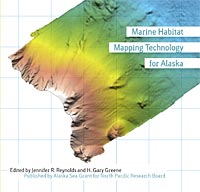
Systematic Acoustic Seafloor Habitat Mapping of the British Columbia Coast
James L. Galloway
- Price: Free
 This is part of Marine Habitat Mapping Technology for Alaska
This is part of Marine Habitat Mapping Technology for Alaska| Format | Price | |
|---|---|---|
| PDF download [399.7 KB] Bypass cart and download |
Free | Add to Cart |
Description
The Canadian Hydrographic Service (CHS) is systematically mapping bathymetry along the British Columbia coast. The multibeam systems used to measure this high resolution bathymetry also record acoustic backscatter in each of many beams. This backscatter can be classified using commercial software tools to ultimately map detailed seafloor geomorphology. Essentially, CHS bathymetric survey platforms become vessels of opportunity for habitat mapping programs. Acoustic backscatter responds to habitat structure in the benthic area because acoustic echoes are sensitive to variations in geologic and biotic components on (and within) the seafloor. The resulting benthic habitat model is one vital component of the complete ecosystem picture, crucial to modern habitat management philosophy. Segmented backscatter by itself is of limited usefulness but, once calibrated by sediment or benthic population samples, a habitat picture evolves. However, there are scaling and other issues that impact the accuracy with which the acoustic diversity can be used to represent the second layer (seabed type) in an ecosystem. CHS applies sediment grab samples, concurrent seafloor video, and high resolution bathymetry to validate acoustic classes. The Strait of Georgia is the current focus of this habitat mapping program, and four areas corresponding to CHS charts are nearing completion.
Item details
- Item number: AK-SG-08-03o
- Year: 2008
- DOI: https://doi.org/10.4027/mhmta.2008.14



